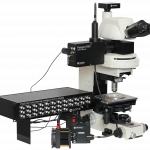Published on 2023/11/27 Research powered by Mightex’s Polygon1000 

Owen Y. Chao, Salil Saurav Pathak, Hao Zhang, George J. Augustine, Jason M. Christie, Chikako Kikuchi, Hiroki Taniguchi & Yi-Mei Yang, Social memory deficit caused by dysregulation of the cerebellar vermis. Nature Communications,1214, 6007 (2023).


Introduction
This study investigates the role of the cerebellum in social recognition memory (SRM) and its impact on social behaviors. Researchers conducted a series of experiments in mice, targeting molecular layer interneurons (MLIs) in the cerebellar vermis to inhibit Purkinje cell firing. Intriguingly, perturbing MLIs adversely affected SRM while leaving other behavioral aspects such as sociability, anxiety, motor coordination, and object recognition untouched.
The study’s key insight came from optogenetic interventions during a social recognition test, uncovering the cerebellum’s involvement primarily in the retrieval phase of social information, as opposed to encoding. The research also delved into brain-wide connectivity patterns, demonstrating that cerebellar manipulation altered the interregional correlations in the brain. The shift in network structure, transitioning from a medial prefrontal cortex and hippocampus-centered model to one centered around the amygdala, was particularly noteworthy.
Moreover, anatomical tracing offered a deeper understanding of the cerebellum’s role by revealing hierarchical projections from the central cerebellum to the social brain network, which incorporates amygdalar connections. These findings collectively propose that the cerebellum plays a pivotal role in organizing the neural framework required for SRM.

Figure 1:Adapted from source Panel 1: APs recorded from MLIs and PCs showing photostimulation increased the AP frequency from MLIs. Panel 2: In a social recognition test, light delivery (25 ms, 8 Hz, 10 s pause every 50 s) in the learning trial did not affect animals’ social approach (explored the stranger more than the cup) or social recognition (explored the novel stranger more than the old one). Same light delivery in the testing trial impaired animals’ social recognition (explored the novel and the old strangers equally) without affecting their social preference (explored the stranger more than the cup).
Methods
For their optogenetic experiments, Chao et al used the OASIS Implant system with a 470nm LED. Channelrhodopsin2 (ChR2) was expressed exclusively in MLIs and light pulses were presented in specific vermal lobules. This precise temporal control allowed scientists to investigate the influence of cerebellar activity at different stages of social recognition memory (SRM).
Behavioral tests were conducted to assess the effects of cerebellar manipulation. These tests included the elevated plus maze, open field test, rotarod test, three-chamber social test, social recognition test, and object recognition test. These experiments evaluated factors such as anxiety, locomotion, motor coordination, sociability, social memory, and object-based recognition memory. Mice that had undergone cerebellar manipulation were compared to control mice to determine the impact of these interventions.
Findings and Conclusion
The study revealed that manipulating the cerebellum, specifically the vermis and MLIs, significantly affected social recognition memory (SRM) in mice. Chemogenetic activation of MLIs led to reduced social recognition, while optogenetic stimulation impaired the retrieval of SRM. Notably, cerebellar manipulation did not impact general anxiety levels, locomotion, social approach, or object-based recognition memory, suggesting that the effects were specific to social memory.
These findings shed light on the intricate role of the cerebellum in non-motor functions such as social cognition and recognition memory. The research implies that the cerebellum plays a specific role in the retrieval and consolidation of social information, rather than in the encoding of such memories. Understanding the cerebellum’s influence on social behavior and cognition can have implications for disorders like autism spectrum disorder (ASD) and may lead to new therapeutic approaches. This study, utilizing optogenetic and chemogenetic techniques, opens up exciting avenues for further research into the cerebellum’s broader functions beyond motor control.
Megha Patwa, Applications Specialist at Mightex
To read the full publication, please click here.



